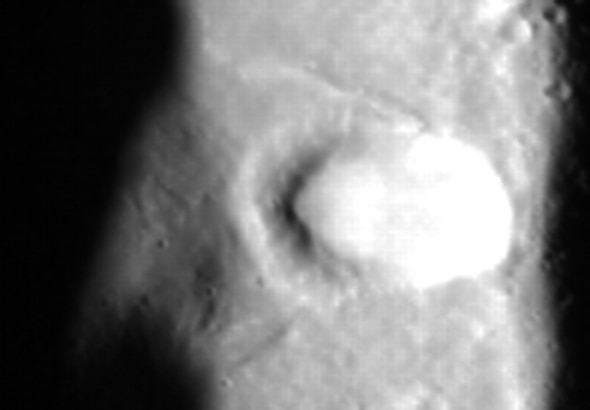Create a free profile to get unlimited access to exclusive videos, sweepstakes, and more!
Two Impacts, One Landslide … on Mercury

When I was a kid, I used to love looking through my telescope at craters on the Moon. Their size, shape, and subtle (and not-so-subtle) differences fascinated me, and still do.
Those differences still pull at me. Some craters are just odd, and that oddness is generally a clue to how they formed … or what happened after they formed.
Mercury is Moon-like in many ways: It has a solid, rocky surface, and no atmosphere to speak of. That means it’s covered in craters, and that in turn means some will have that fun weirdness. Here’s one for your impactful enjoyment:
That image above was taken on July 19, 2014, by the ever-vigilant MESSENGER spacecraft, which has been orbiting the closest planet to the Sun for the past three years. The image is about 9 kilometers (5.5 miles) across and shows part of a largish crater. The Sun was only about 20° above the local horizon (shining from the left), so the crater rim shadow covers most the floor. You can just see part of a central mound peeking out from the shadow (common in larger craters, due in part to material in the center flowing upwards, rebounding, after the initial impact).
You can see smaller impact craters dotting the crater, but right in the middle of the big crater wall is the weirdly shaped crater. Here’s a close-up:
At first you might think that feature in the middle with the wide, humped rim is the crater, but it’s not. In fact, the impact is the overexposed round feature just upslope a bit on the big crater’s wall. Impacts inside previously established craters are common on airless worlds like Mercury, since they get hit a lot. But this one is different because it looks like the event triggered a massive landslide.
The impact was huge; when the asteroid or comet slammed into the older crater’s wall it exploded with a yield far larger than any human-made nuclear weapon, leaving a pit a kilometer cross. The energy must have shaken the ground mightily, dislodging the material around it. That caused the huge runoff (what geologists call a “mass wasting event”) that flowed down the bigger crater’s wall, creating that wide crescent-shaped feature when it finally stopped.
You can also see a much wider fan of material spreading out around the crescent, getting wider toward the big crater’s floor. I suspect that’s lighter debris that flowed around the other debris. That very upper edge of the fan is interesting; it appears to be bright on the inside (toward the bottom of the frame) and darker on the outside. Given the Sun shining from the left, that makes it seem to me that the edge is actually a raised ridge; the inside edge lit by the Sun, the outside edge slightly in shadow. The resolution of the picture on that scale is low, so I can’t be sure. But that all seems to hang together.
What an interesting spot! Geologists like craters because they don’t have to dig down to sample older material; the impacting asteroid did that work for them. And here we have another crater exposing the ground underneath that, and a huge landslide on top that tells them even more about the consistency and constitution of the surface material. It’s a scientific bonanza.
Now all we need to do is get a geologist there to poke around. I wonder how long it will be until a human wanders the surface of this tiny and terribly hot world, exploring the amazing sights there?


























